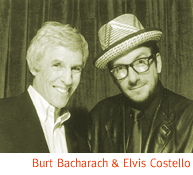

|

How Is It That A Master Of '70s Cheese Is A Late '90s Musical Guru?
By Dave McElfresh
IMAGINE A 1988 psychic predicting that in 1998 Burt Bacharach--a
'60s-era composer who wrote hits for unhip popsters like the Carpenters,
Herb Alpert, Dionne Warwick, The Fifth Dimension and B.J. Thomas--would
become hot stuff among a jaded music crowd young enough to be
his grandkids. "Yeah, right," you'd say, "and the
Enquirer says Jesus will be back in time for the Rose Bowl."
 But, oddly, it happened--or rather, is happening--with Bacharach's
career in full swing again. The first paean was last year's tribute
album, What The World Needs Now..., where young whippersnappers
like Splitsville and Shonen Knife covered "I'll Never Fall
In Love Again" and "I Say A Little Prayer." This
year, we've got The Look Of Love, a well-researched, three-disc
career overview on Rhino Records, and Rykodisc's reissue of Bacharach's
soundtrack to What's New Pussycat?, complete with
CD-ROM videoclip from the movie. Then there's label N2K's soundtrack
to the TV special, Burt Bacharach: One Amazing Night (featuring
Chrissie Hynde, Sheryl Crow, Mike Myers, Ben Folds Five and others),
and several reissues of 30-plus-year-old Bacharach albums. Most
impressive, though, is his recent writing collaboration with Elvis
Costello, Painted From Memory, which proves that Bacharach
isn't content to settle for the nostalgia thang.
But, oddly, it happened--or rather, is happening--with Bacharach's
career in full swing again. The first paean was last year's tribute
album, What The World Needs Now..., where young whippersnappers
like Splitsville and Shonen Knife covered "I'll Never Fall
In Love Again" and "I Say A Little Prayer." This
year, we've got The Look Of Love, a well-researched, three-disc
career overview on Rhino Records, and Rykodisc's reissue of Bacharach's
soundtrack to What's New Pussycat?, complete with
CD-ROM videoclip from the movie. Then there's label N2K's soundtrack
to the TV special, Burt Bacharach: One Amazing Night (featuring
Chrissie Hynde, Sheryl Crow, Mike Myers, Ben Folds Five and others),
and several reissues of 30-plus-year-old Bacharach albums. Most
impressive, though, is his recent writing collaboration with Elvis
Costello, Painted From Memory, which proves that Bacharach
isn't content to settle for the nostalgia thang.
How in hell did this weird Burt revival come to be? There are
loads of reasons why it shouldn't have. His career resurrection
falls outside the usually accurate 20-Year Revisitation Theory
(where '90s music fans return to '70s disco, just as '70s American
Graffiti fans brought about a '50s music revival). And his
occasional post-'60s collaborations with Christopher Cross, Michael
McDonald, Neil Diamond and Elton John were uniformly dreadful,
canceling out any possibility that he's been an overlooked, formidable
presence in music all along.
As with anything complicated--and music trends are definitely
that--most likely more than one reason lies behind the Hey-Burt
phenomenon. Here are some possibilities:
- Being cool is always a matter of bucking whatever's been
current too long. The badass/shock value schtick has pretty well
worn itself out, with one band or another appearing naked onstage
or representing Satan Hisself. Where do you go from there? Nowhere
but the other direction, where the uncool becomes cool--from Sean
Lennon's doofus horn-rimmed glasses to flare pants to acid jazz's
bastardization of bossa nova to a revival of interest in Bacharach.
- Pop music has become secure enough with its inherent faddishness
that it can afford to poke fun at previous incarnations. Mike
Myers' Austin Powers, which featured Bacharach in
a cameo, is the best recent example. While those old enough to
actually remember the '60s wince at the attempts at pseudo-hipness
Myers painfully exhumes, Bacharach's music floats in the background
like a buoy, 30-some years after the passage of our groovy youthfulness.
It brings to mind a sinking feeling.
- The recent so-uncool-it's-cool lounge scene seems to have
begun with adolescents hungry for music, but either unwilling
or unable to drop the better part of 20 bucks for a CD. Thrift
shops had loads of music for as cheap as a quarter an album, leading
to experimentation with donated, post-divorce record collections
featuring Esquivel, The Mystic Moods Orchestra, Tom Jones and
Bacharach. All of them have since come to represent a new definition
of cool.

- Anyone wanting further, post-career attention in pop music
does well by succumbing to one form or another of tragedy or kitsch.
Karen Carpenter ("Close To You") died of anorexia, and
Dionne Warwick (responsible for too many Bacharach hits to count)
represented a goofy psychic network that couldn't even predict
its own bankruptcy. Tom Jones ("What's New Pussycat?")
was Vegas machismo all the way. Scott Walker ("Any Day Now,"
"Make It Easy On Yourself") became the intriguing musical
equivalent of recluse J.D. Salinger. All of these off-kilter artists
unintentionally kept Bacharach's material from sounding too cutesy.
- While hip-hop has become popular due to its updating of
funk rhythms stretching back to the '40s, it remains melodically
as monotone as a refrigerator hum. Sorry, DJ Wunnote, but we gotta
have some melody. And apart from (and usually equaling) the Beatles,
nobody's more melodic than Bacharach.
The musicians paying tribute to Bacharach on his recent television
special are figures at least a generation older than many of the
viewing audience. So, a 43-year-old Costello and a 36-year-old
Sheryl Crow, who grew up in homes with a family record collection
containing Bacharach's stuff, pass on their appreciation to those
fewer in years, the same way other artists have led the under-20
bunch into checking out the Beatles.
Even today, Bacharach is still churning out some serious shit,
as is evident on the Costello collaboration; and in particular,
the obvious future standard, "This House Is Empty Now."
If you want to conjure your own psychic vision for pop's future--one
that Warwick would do well to invest in--bet that Bacharach will
soon pair up with other singers and writers for albums that'll
further validate his status as a popular composer, on par with
Cole Porter and Antonio Carlos Jobim.

|
 |





